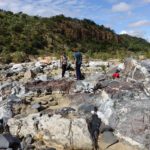Curtin University research has shown volunteer firefighters are at a greater risk of coronary heart disease (CHD) than other volunteer and paid emergency services personnel and that the risk could be exacerbated by the extreme conditions in which they work.
Dr Kevin Netto, Senior Lecturer in Curtin’s School of Physiotherapy and Exercise Science, undertook a study of more than 2900 volunteer firefighters in Victoria, in conjunction with colleagues from Deakin University, the Country Fire Authority (CFA), the Bushfire Co-operative Research Centre and Public Health Management Pty Ltd.
The firefighters were assessed for a variety of CHD risk factors – age, sex, smoking, blood pressure, cholesterol and glucose – and a total risk score was calculated for each participant.
“The results were concerning and showed volunteer firefighters could be putting themselves at considerable risk of CHD because of the work they are required to do,” Dr Netto said.
“Among the male volunteer firefighters involved in our study, the predicted 10-year risk of CHD was considered similar to the general population.
“This is a big concern because volunteer firefighters are subject to unique occupational demands that the general population isn’t – bursts of high intensity activity performed in a potentially hazardous environment, with long shifts and shortened sleep patterns.
“These factors can place considerable stress on the cardiovascular system.”
Dr Netto explained volunteer firefighters did not appear to benefit from the same healthy work environment (HWE) effects as other emergency services workers.
“Previous studies in Australia and overseas have shown both volunteer and paid workers in other emergency services roles had a lower risk of CHD than the group of firefighters we studied,” Dr Netto said.
“An HWE is characterised by a reduced mortality rate compared to general workplaces, because of the exclusion of disabled and ill people from that type of employment.
“Not only does it appear volunteer firefighters don’t benefit from an HWE, it is likely they aren’t subject to the same health checks as their paid counterparts, nor would they receive the same frequency or level of physical training.
“Given the crucial role volunteer firefighters have in Australia – including working at Victoria’s Black Saturday fires and the recent destructive blazes in New South Wales – our research clearly supports a case for improved health and fitness guidelines and cardiovascular health interventions.”
The volunteer firefighters involved in the study were aged between 30 and 74 and the prevalence of CHD risk factors was then compared with people of the same age and sex considered to be at low risk.
The predicted 10-year risk of CHD for the volunteer firefighters was three times that of their low risk counterparts.
“The study is the first of its type in Australia, and to date, there has also been very little worldwide research into the health of volunteer firefighters. So it is of international importance,” Dr Netto said.
The CFA is now implementing the research in Victoria, with ongoing testing of volunteer firefighters and an information roadshow that goes to remote and regional centres.


